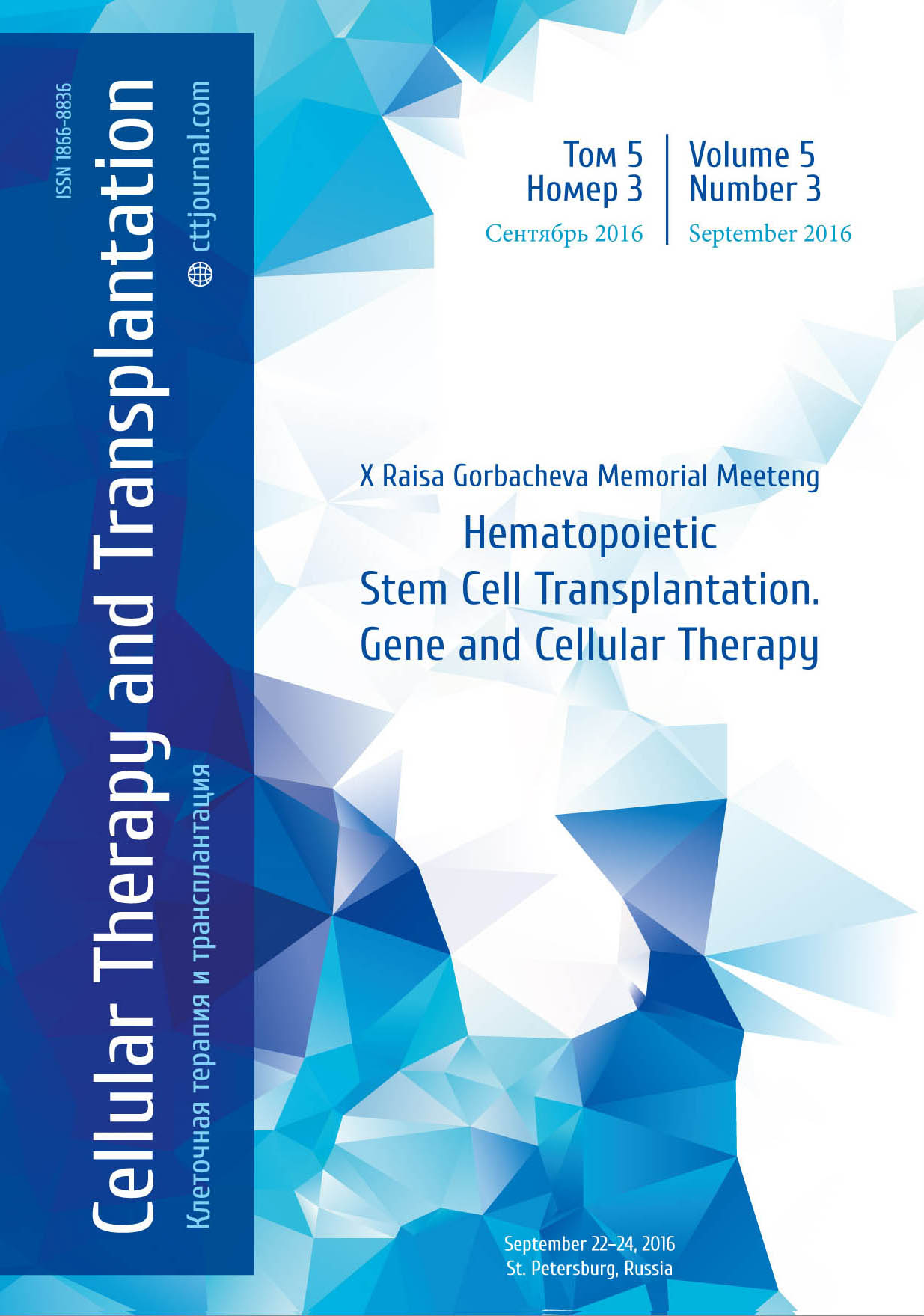Predictive value of cytokine levels for acute graft-versus-host disease in hematopoietic stem cell transplantation with post-transplant cyclophosphamide
2Laboratory of Autoimmune Diagnostics, First St.Petersburg State I.P. Pavlov Medical University, St. Petersburg, Russian Federation
Accepted 20 September 2016
Summary
Background
Currently, acute graft-versus-host-disease (GVHD) remains one of the most serious complications of allogeneic hematopoietic stem cell transplantation (НSCT). The release of large amounts of cytokines causes activation of alloreactive T-cells in the early period after transplantation is an important step in pathogenesis of acute GVHD. The basic immunological events leading to GVHD occur during several weeks after hematopoietic graft transfusion. By this reason, cytokine profiling could be used to predict development of GVHD. The majority of studies on cytokines in allogeneic HSCT were performed with classical GVHD prophylaxis, consisting of non-specific immunosuppressive agents like calcineurin inhibitors, methotrexate, mycophenolate mofetil, anti-thymocyte globulin, etc. When using this type of prophylaxis, most studies agree in that higher levels of pro-inflammatory cytokines are associated with development of acute GVHD, while lower levels indicate a successful immunosuppression in abrogation of alloreactive response. Recently, many transplant centers are interested in a novel approach for the GVHD prevention based on Cyclophosphamide post-HSCT (PTCy). Currently, there is no clarity, whether cytokine changes after PTCy are similar to the situation with classical GVHD prophylaxis. It is also unclear if well-known predictive biomarkers remain valid after PTCy-based prophylaxis. Trying to answer these questions, we have conducted a pilot study to determine the dynamics of plasma cytokines in patients undergoing HSCT with PTCy for GVHD prophylaxis. For this pilot study, we have selected five cytokines, IL-17, IL-6, IL-8, IFN-γ, and TNF-α, that were shown to have predictive value for acute GVHD. We, therefore, compared their levels in patients who developed acute GVHD versus GVHD-free cases.
Patients and Methods
Among 192 patients transplanted with PTCy prophylaxis at The First State I.P. Pavlov Medical University between 2014 and 2015, we have identified 20 cases with acute GVHD and plasma samples available. These patients were matched to patients who did not develop acute GVHD at a 1:2 ratio. By decreasing priority, the matching criteria were as follows: donor type, graft source, intensity of the conditioning regimen, primary diagnosis, and disease status. Thus, the study group consisted of sixty adult patients with hematological malignancies who underwent HSCT. All patients have signed informed consent for the collection of blood samples and use of their personal data for research purposes. 28% were grafted from related donor, 72% – from unrelated. The patients received either myeloablative conditioning (MAC) with oral Busulfan (16 mg/kg) and Cyclophosphamide (100 mg/kg), or reduced-intensity conditioning (RIC) with oral Busulfan 8 mg/kg and Fludarabine 180 mg/m2 . All the patients received PTCy- based GVHD prophylaxis. For recipients transplanted from 10/10-HLA matched unrelated donors (MUD), GVHD prophylaxis included combination of Cyclophosphamide (50mg/kg) on day +3,+4, Tacrolimus with target concentration of 5-15 ng/ ml from day+5 through day+120, and Mycophenolate Mofetil (MMF) at 30 mg/kg, or 45 mg/kg for 8-9/10 mismatched unrelated donors (MMUD) from day+5 through day+35. For matched related donors (MRD) with bone marrow as graft source, GVHD prophylaxis was a single-agent Cyclophosphamide (50mg/kg) on day +3, +4. For blood testing, 10 mL of EDTA-preserved venous blood were obtained from the patients on days -7, 0, +7, +21 and +28. Plasma samples were obtained by centrifugation at 1000 g, and then stored in aliquotes at -80°C until the day of assays. We studied 5 plasma biomarkers, i.e., IL-17A, IL-6, IL-8, TNF-α and IFN-γ. Appropriate plasma levels were measured with ELISA technique using commercially available kits (Сytokine, St.Petersburg, Russia). All the assays were performed in compliance with protocols provided by the kit manufacturer. The cytokine concentrations were measured without knowledge of individual clinical data.
Results
Of sixty patients included into the study, twenty recipients developed aGVHD grade I-IV, whereas forty patients were GVHD-free. Eight of these 20 patients (40%) had grade I; 7 (35%) grade II; 5 (25%) grade III aGVHD. 6 patients (30%) developed a systemic aGVHD. There was no difference in cytokine concentrations between GVHD+ and GVHDgroups. The levels of all the cytokines under study did not show any correlations with a risk for aGVHD grades I-IV. We have not received significant differences between the concentrations of cytokines in the study groups at any time point (p>0.05). Noteworthy, additional comparisons between the groups with systemic GVHD and without GVHD have shown lower levels of several plasma cytokines in patients who did develop GVHD. A reduced mean level of IL-8 (98.74±39.47 vs 276.09±284.78 pg/ml, p=0.008 for GVHD+ and GVHD-, respectively), and IFN-γ (22.69±16.35 vs 60.07±42.00 pg/ml, p=0.005 for GVHD+ and GVHD-, respectively) at day +28 were significant risk factors for aGVHD occurrence. By ROC analysis, cutoff values were determined for IL-8, as (147.09 pg/ml; AUC= 0.833), and for IFN-γ (35.94 pg/ml; AUC= 0.848). Incidence of systemic aGVHD was significantly higher in patients with cytokine levels under the cutoff values (0% vs 35.3%, p=0.002, and 3.8% vs 38.5%, p=0,003, for IL-8 and IFN-γ, respectively).
Conclusions
In summary, our pilot trial has shown that time dynamics of cytokine levels after GVHD prophylaxis with PTCy might be different from those under conventional immunosuppressive treatment. Likewise, the well known predictive biomarkers might not work after PTCy. Further large prospective trials could elucidate the differences and determine reliable predictors for acute GVHD. Moreover, it also may be important to introduce additional time points for blood sampling before PTCy administration.
Keywords
Allogeneic hematopoietic stem cell transplantation, cyclophosphamide, gvhd prevention, cytokines, blood plasma
Accepted 20 September 2016


